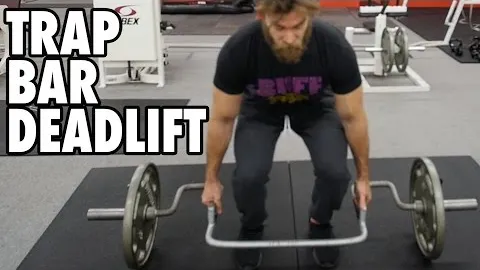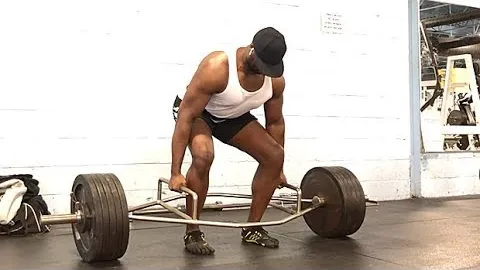

The TRAP BAR DEADLIFT: A Complete Guide to Maximizing Your Strength and Power
If you are someone who is looking to build strength and power, the trap bar deadlift is a highly effective exercise that you should consider incorporating into your workout routine. This compound movement targets multiple muscle groups and can help you achieve optimal results in terms of both strength gains and muscle development.
In this article, we will provide you with a comprehensive guide to the trap bar deadlift, including its benefits, proper form and technique, and how to incorporate it into your training program. By the end, you will have all the information you need to start reaping the rewards of this powerful exercise.
The trap bar deadlift, also known as the hex bar deadlift or the trap bar lift, is a variation of the traditional barbell deadlift. It involves using a hexagonal-shaped barbell where the lifter stands in the center of the bar. This design helps reduce stress on the lower back and places more emphasis on the quadriceps and glutes, making it an ideal exercise for those who may struggle with lower back issues.
The trap bar deadlift offers numerous benefits for individuals of all fitness levels. Some of the key advantages include:
Increased Strength: The trap bar deadlift is a compound exercise that targets multiple muscle groups, including the quadriceps, hamstrings, glutes, and upper back. By consistently performing this exercise, you can enhance your overall strength and power.
Reduced Risk of Injury: Compared to the traditional barbell deadlift, the trap bar deadlift places less stress on the lower back. This makes it a safer option for individuals who may have existing back issues or are new to weightlifting.
Muscle Development: The trap bar deadlift recruits a wide range of muscles, making it an exceptional exercise for building muscle mass and creating a well-balanced physique.
Improved Athletic Performance: This exercise mimics many real-life movements, such as picking up heavy objects from the ground. By incorporating the trap bar deadlift into your training program, you can improve your overall functional strength and enhance your athletic performance.
Versatility: The trap bar deadlift can be customized to suit your individual needs and goals. By adjusting your stance, grip, and implementing variations such as deficit or paused trap bar deadlifts, you can further target specific muscle groups or increase the exercise's difficulty.
To perform the trap bar deadlift correctly and safely, follow these steps:
Set Up: Start by standing in the center of the trap bar with your feet shoulder-width apart. Your shins should be touching the bar, and your toes should be slightly pointed outwards.
Grip: Reach down and grip the handles of the trap bar with an overhand or mixed grip. Ensure that your grip is comfortable and secure.
Positioning: Brace your core, keep your chest up and your shoulders back. Maintain a neutral spine throughout the movement.
Lift Off: Push through your heels and drive your hips forward as you stand up, lifting the bar off the ground. Extend your legs fully while keeping your arms straight.
Lockout: Once you are in a fully upright position, squeeze your glutes and engage your core to achieve a complete lockout at the top.
Lowering: Slowly lower the bar back down to the starting position while maintaining control and keeping your back straight. Repeat for the desired number of repetitions.
Including the trap bar deadlift in your training program can yield substantial results. Here are a few tips for incorporating this exercise into your routine:
Warm-Up: Prior to performing the trap bar deadlift, warm up your muscles and activate your core with exercises such as bodyweight squats, hip hinges, and glute bridges.
Progressive Overload: As with any strength training exercise, gradually increase the weight over time to continually challenge your muscles and promote growth. Start with a weight that allows you to perform proper repetitions with good form, and gradually add weight as you become stronger.
Frequency: Aim to include the trap bar deadlift in your routine at least once a week. As you become more advanced, you may choose to increase the frequency.
Variations: To further challenge your muscles and prevent plateaus, experiment with variations such as deficit trap bar deadlifts, paused reps, or single-leg trap bar deadlifts.
The trap bar deadlift is a highly effective exercise for building strength, power, and muscle mass. With its unique design and reduced stress on the lower back, it offers an excellent alternative to traditional deadlifts. By incorporating the trap bar deadlift into your training program and following proper form and technique, you can maximize your gains and unlock your full potential. Start adding this exercise to your routine and experience the transformative benefits it has to offer.
If you're looking for a gym, fitness club or yoga studio, you've come to the right place.
You can find information about gyms in your area. Browse catalog of gyms and find gyms with classes which are you looking for.
On gym page you can find simple information like address, phone or website. You can find list of available classes. You can check availability of personal training or small group classes. On place page you can also see information about open hours.
You can find gyms near you with amenities, courts, studios and equipments.
Use our map to find gym at your city or district.
In Gym Navigator you can find list of exercises with movies for many body parts.
You can browse exercises catalog and find exercises the best of you.
You can also find exercises grouped into workout plans, which you can use to improve you body. Each routine show you exercises one by one and give you possibility to count you progress and count down rest time.